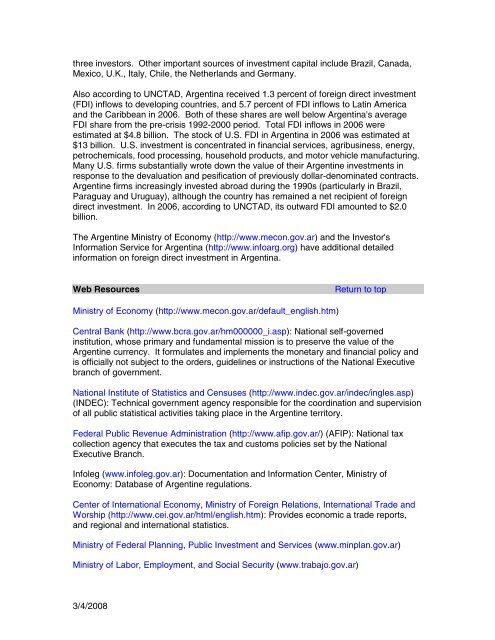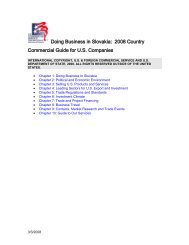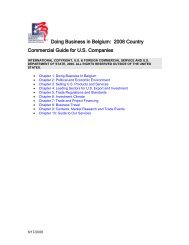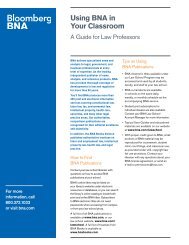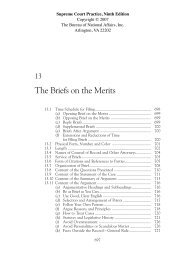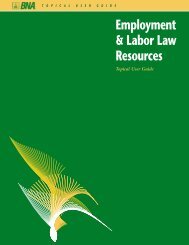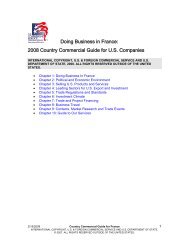Create successful ePaper yourself
Turn your PDF publications into a flip-book with our unique Google optimized e-Paper software.
three investors. Other important sources of investment capital include Brazil, Canada,<br />
Mexico, U.K., Italy, Chile, the Netherlands and Germany.<br />
Also according to UNCTAD, <strong>Argentina</strong> received 1.3 percent of foreign direct investment<br />
(FDI) inflows to developing countries, and 5.7 percent of FDI inflows to Latin America<br />
and the Caribbean in 2006. Both of these shares are well below <strong>Argentina</strong>'s average<br />
FDI share from the pre-crisis 1992-2000 period. Total FDI inflows in 2006 were<br />
estimated at $4.8 billion. The stock of U.S. FDI in <strong>Argentina</strong> in 2006 was estimated at<br />
$13 billion. U.S. investment is concentrated in financial services, agribusiness, energy,<br />
petrochemicals, food processing, household products, and motor vehicle manufacturing.<br />
Many U.S. firms substantially wrote down the value of their Argentine investments in<br />
response to the devaluation and pesification of previously dollar-denominated contracts.<br />
Argentine firms increasingly invested abroad during the 1990s (particularly in Brazil,<br />
Paraguay and Uruguay), although the country has remained a net recipient of foreign<br />
direct investment. <strong>In</strong> 2006, according to UNCTAD, its outward FDI amounted to $2.0<br />
billion.<br />
The Argentine Ministry of Economy (http://www.mecon.gov.ar) and the <strong>In</strong>vestor's<br />
<strong>In</strong>formation Service for <strong>Argentina</strong> (http://www.infoarg.org) have additional detailed<br />
information on foreign direct investment in <strong>Argentina</strong>.<br />
Web Resources Return to top<br />
Ministry of Economy (http://www.mecon.gov.ar/default_english.htm)<br />
Central Bank (http://www.bcra.gov.ar/hm000000_i.asp): National self-governed<br />
institution, whose primary and fundamental mission is to preserve the value of the<br />
Argentine currency. It formulates and implements the monetary and financial policy and<br />
is officially not subject to the orders, guidelines or instructions of the National Executive<br />
branch of government.<br />
National <strong>In</strong>stitute of Statistics and Censuses (http://www.indec.gov.ar/indec/ingles.asp)<br />
(INDEC): Technical government agency responsible for the coordination and supervision<br />
of all public statistical activities taking place in the Argentine territory.<br />
Federal Public Revenue Administration (http://www.afip.gov.ar/) (AFIP): National tax<br />
collection agency that executes the tax and customs policies set by the National<br />
Executive Branch.<br />
<strong>In</strong>foleg (www.infoleg.gov.ar): Documentation and <strong>In</strong>formation Center, Ministry of<br />
Economy: Database of Argentine regulations.<br />
Center of <strong>In</strong>ternational Economy, Ministry of Foreign Relations, <strong>In</strong>ternational Trade and<br />
Worship (http://www.cei.gov.ar/html/english.htm): Provides economic a trade reports,<br />
and regional and international statistics.<br />
Ministry of Federal Planning, Public <strong>In</strong>vestment and Services (www.minplan.gov.ar)<br />
Ministry of Labor, Employment, and Social Security (www.trabajo.gov.ar)<br />
3/4/2008


